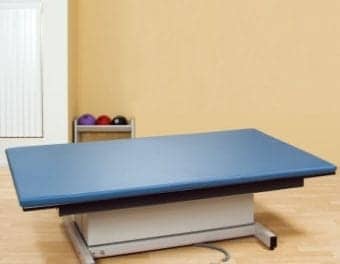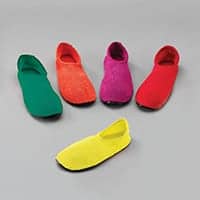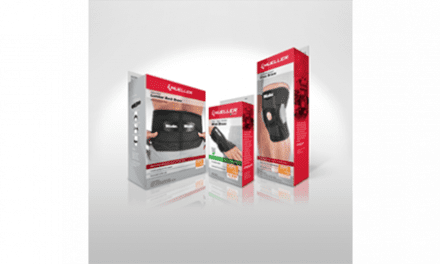PHOTO CAPTION: Vicon’s motion capture technology collects athletic performance data that can help improve performance as well as assist with injury rehabilitation and promote injury prevention.
By Tim Sell, PhD, PT, and Kim Duffy, PhD
In the world of competitive sports, milliseconds matter — remember Michael Phelps’ .01-second victory over Milorad Cavic during his record-busting 2008 Olympics? It’s a moment that couldn’t have happened without technology — both the technology to capture the finish-line images and the technology that helped Phelps perfect his performance.
Flash forward more than a decade, and margins are closer than ever. Athletes at every level — not just Olympians like Phelps — have access to cutting-edge motion-capture and wearable technology that measures, assesses, and improves performance. But it often takes an injury for athletes and teams to understand just how crucial this technology is to long-term success. Tech has the power to accelerate and aid athletes’ return-to-play — and prevent future injuries from occurring.
Inertial Technology: Improve Athletic Performance in Real Time
While training season lengths vary wildly from sport to sport, no athlete wants to wait weeks to see results. Thankfully, inertial measurements units (IMUs) within wearable sensors can now be strapped to athletes’ ankles or wrists to immediately capture acceleration, workload, joint angle, and other performance data points to precisely quantify an athlete’s movement during a training session or competition. For a more comprehensive look at the data, trainers and coaches can use optical motion capture camera systems to collect 3D performance data. This wealth of data helps create actionable, measurable short- and long-term goals for athletes, coaches, and trainers.
Perhaps at no moment are these data points and goals more important than when an athlete is recovering from an injury. Peak performance data helps inform long-term goals, while daily stats can help you personalize rehabilitation programs so they’re based on progress criteria and milestones, instead of time, significantly reducing guesswork and risk.
Tip: Athletes’ best, most accurate performance data will be captured wherever they typically perform — whether in a pool, on a court, or in a rink.
Use Motion Capture to Determine Injury Risk Factors and Prevent Future Harm
Athletic injuries are caused by a combination of factors unique to the individual, and the success of their treatment relies on a clinician or physical therapist correctly identifying the underlying risk factors to avoid re-injury.
Traditionally, PTs have faced challenges when it comes to gathering accurate, objective data to develop injury prevention and rehabilitation programs. For example, prospective risk analyses are necessary for identifying target variables for injury prevention, such as plyometrics, agility, flexibility, and dynamic reflexes, but they are logistically challenging and cost-intensive. And even with the best planning and execution, these studies still may not identify any risk factors.
In the past, a lack of quality, 3D movement data to examine injuries, such as a ruptured anterior cruciate ligament (ACL), hindered PTs from gaining a complete view. But today’s motion capture systems are breaking down barriers. This modern technology can more accurately identify which movements have an increased probability of injury or track improvements in rehabilitation and performance optimization.
Currently, PTs use motion capture systems to examine sport-specific or demand-specific movement patterns that often lead to injuries. For example, stop-jump tasks that require a sharp deceleration and change of direction (COD) include components that have been identified as aspects of non-contact ACL injuries. Use motion capture systems to study athletes and determine whether the movement patterns predispose them to injury.
Tip: While some sports are proven more likely to cause injury among young athletes than others, those who specialize in just one sport are 81% more likely to experience an overuse injury — no matter their activity of choice.
Leverage Motion Capture for Gait Analysis
Just as every athlete’s risk factors and performance data differs, so too does each person’s gait. That’s why one of the most common use cases for motion capture systems is the analysis of an athlete’s motion pattern while walking, running or completing return-to-play exercises like squats or lunges. However, the practice has not come without its challenges, including accuracy and a lack of standardization.
• Accuracy. In its simplest form, 2D or video gait analysis helps you estimate the position and orientation of a patient’s lower limbs via video footage captured by a single camera. However, this footage is limited to the sagittal and coronal planes, which means PTs cannot accurately quantify the patient’s body poses. Timing issues and cross-plane interactions are also difficult to detect using only video footage. Three-dimensional gait analysis addresses these limitations by using motion capture systems, which use more than one camera, often with small, lightweight inertial sensors taped to the patient’s lower limbs and force plates, to track movement and measure, with a high degree of accuracy, the kinematics of the joints in the lower limb and facilitate the interpretation of kinematic deviations.
• Assessment standardization. In the past, gait analysis was a time-intensive process that resulted in lengthy reports, thanks to a lack of standardized assessment protocols. Clinicians and PTs were left with contrasting results that could not be easily compared across studies. To solve this issue, biomechanists developed the Conventional Gait Model (CGM), which established a standard set of marker placements and assessment algorithms to make it easier for PTs to understand and act on the data collected.
With 3D gait analysis and CGM, you can rapidly collect accurate data about an injured athlete’s movement patterns. The most common site of running-related injuries is the knee, due to underlying causes like muscular inflexibilities, decreased stability, lack of control, or knee loading. Three-dimensional gait analysis collects quantitative assessments of the athlete’s strength, flexibility, motor control, function and anatomical structure to identify contributing issues. The information is then used to create a personalized, evidence-based rehabilitation program.
Tip: If an athlete used motion capture for performance improvement and analysis prior to an injury, this previously captured data can serve as a progress baseline instead of relying on standardized, time-based rehab recommendations.
Leverage Motion Capture for Rehabilitation
The value of motion capture doesn’t end once an athlete has recovered. At this point, you still need to develop comprehensive injury prevention programs. Motion capture systems can include force plates — tools that measure ground reaction forces during movement — that can also be used to examine postural stability. Postural stability assessments, along with strength, flexibility, and range of motion testing, can be combined with motion capture to provide a more comprehensive picture of the athlete’s neuromuscular and musculoskeletal capabilities.
Motion capture systems have recently paired the power of wearable inertial sensors with augmented reality (AR), which adds real-time 2D and 3D skeletal overlays on video footage of athletes during rehabilitation. These visual aids can increase the athlete’s understanding of and buy-in to the program and give trainers and coaches a new method for tracking progress.
Thanks to recent advancements in motion capture systems, teams of biomechanists can treat more patients in less time. Dublin’s Sports Surgery Clinic, for example, sees as many as 10 patients per day, which adds up to addressing nearly 1,000 ACL reconstructions and 400 to 500 knee injuries in 1 year. This wealth of data allows the team to continuously enhance rehabilitation methods. Once an athlete has completed their program, results are entered into databases that use machine learning algorithms to find commonalities, which help determine and improve programs for future patients.
Tip: While each athlete’s data is unique to their sport and body, comprehensive data analysis tools allow biomechanists to spot overall trends and patterns.
By considering objective data when developing injury prevention and rehabilitation programs, athletes can benefit from a holistic approach that coaches, managers and trainers can all see and believe. As the sports world continues to evolve, technology will change with it, playing a bigger role over time both in enhancing performance strategy and risk prevention, and rehabilitation. Motion capture technology has allowed both PTs and athletes alike to experience the best of both these worlds. PTP
Tim Sell, PhD, PT, received a Bachelor of Science in Physical Therapy, a Master of Science in Human Movement Science (Biomechanics Focus) from the University of North Carolina at Chapel Hill, and completed his PhD in Rehabilitation Science from the University of Pittsburgh. During his research career, Sell has focused on the role of functional joint stability in the prevention of musculoskeletal injuries; in recovery following injury; and in re-establishing neuromuscular control following surgery. He has conducted research in many different populations from youth athletes to masters athletes; recreational active individuals to professional athletes; and in military servicemen and women.
Kim Duffy, PhD, earned her doctorate from the University of Essex. She also holds a first class Bachelor’s degree in Sports Sciences as well as a Master’s in Biomechanics of Gait and Posture. At the University of Essex Duffy focused on using a Vicon motion capture system to explore the effects of age on gait and functional movement characteristics in older adult populations. Duffy joined Vicon in 2017 as a Support Engineer and quickly advanced to Life Sciences Product manager. She initially developed an interest in biomechanics through sports, having played football professionally for Sheffield Wednesday Ladies FC. After several knee injuries, she was introduced to motion capture technology through the rehabilitation process and sought to pursue a career in it. For more information, contact [email protected].




